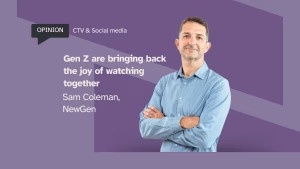NDA’s exclusive roundtable event, hosted in partnership with Nexxen, saw leading CTV publishers discuss the need for standardisation in programmatic CTV and whether it’s the buy or sell-side partners who need to take the first step. Season spoiler: There are no easy answers.
If the wider programmatic universe, and programmatic CTV in particular, is one thing, it’s everchanging. Even experts deep in the weeds of digital advertising acknowledge that many are still playing catch-up. Chris Edwards, Senior Director, Media at Rakuten Advertising, explains that there’s still a lot of learning going on. “A lot of what programmatic buyers want to achieve today what they used to be able to achieve on desktop. Another common challenge is the disconnect between planners and programmatic buyers and identifying the brand KPIs versus programmatic KPIs. Education and connecting the dots in agency land.”
“There’s still a significant gap in understanding between digital-first programmatic buyers and traditional TV planners when it comes to effectively navigating the VOD and linear landscape, agrees Zach Belmont, VP, International Programmatic Revenue, Paramount.
As an industry, we need to bridge this divide by fostering a hybrid approach that combines the strengths of both programmatic and traditional TV buying methodologies. It’s not about pushing for a purely programmatic-first strategy, but rather about creating a more integrated and flexible system that can adapt to the evolving media landscape.”
The biggest piece here doesn’t seem to be technology, but culture. Alex Wright, Programmatic & Data Leader at Channel 4, explains that everything from budget to campaign strategy has shifted in a clash of “old world, new world”. “Which team at the agency is making decisions – we’ve launched a much better PMP offering, and it should be bought by programmatic specialists. We have an additional layer of complication because we need approval for all our copy. It’s additional steps and another level of education.”
Standardisation has been proposed as one solution to address these challenges, but it comes with its own set of complexities. Ryan Afshar, Head of Publishers and Programmatic Platforms, International at LG Ad Solutions, highlights a key debate: as suppliers, they could take the lead in establishing standards for the buy side, but he also suggests that perhaps the impetus for standardisation should originate from the buy side.
“There are different standards and buying methods depending on whether you’re working with an AV or digital team. TV remains the only media channel to undergo a digital transformation while still anchored to the same device. This shift has further entrenched silos within agencies, making it even more challenging to align strategies. Standardisation needs to start on the buy side; only then can we adapt to their preferences and establish consistent standards,” he explains.
Rakuten’s Edwards and Alex Hodge, Head of Digital Ad Sales & Innovation, Warner Bros. Discovery both agree that buy-side standardisation would be “fantastic” in the former’s words, but impractical, not least because of the huge diversity in who owns the strategy and budget across the industry.
“Agencies are taking different strategies for how they invest into the streaming ecosystem: for some you’ve got AV teams managing budgets and decisions on activation, whether that be programmatic or direct. But with others, budgets are managed across video as a whole and passed to different teams to activate to achieve specific KPIs. This offers more freedom to teams to take informed decisions,” Hodge offers. “There’s fragmentation in education but also what budgets contribute to spend into the ecosystem. Where is the money coming from – is it TV, social, online video?”
Steven Broadhead, MD EMEA, Nexxen would argue that there’s not going to be a one size fits all approach. “Some buyers want to go the SPO route, but we’re also seeing clients who need their hands held by someone with a more holistic view. We need to find a balance to make everyone comfortable.”
This may be the reality but there’s an impatience to resolve the standardisation issue quickly. “The battle that’s going on with the agencies needs to be figured out pretty quickly,” cautions Andy Jones, Head of UK Sales, Samsung Ads. “In the meantime, we’re just going directly to clients who are interested in where their audiences are. In our world, streaming should be the pillar of all campaigns with incremental reach being driven by linear.”
“You can’t ignore the elephant in the room, YouTube, and how much it’s growing on TV,” adds Richard Brant, Senior Director, Advanced TV, Strategy & Partnerships, Vevo. “But there is standardisation that can be done. I can stitch everything together, do it from a third-party measurement point of view and find common denominators across every platform – you can get everything together.”
The complexity of the programmatic universe, whether that’s in CTV or elsewhere, has often meant that audience data and information is more opaque than it could be. Rachel Gargett, Director of Strategic Account Management, Nexxen, calls for a focus on standardisation here, too. “Buyers don’t necessarily see viewership data or contextual changes in the programmatic environment. Is there a way we could standardise and unify the different data signals that come through programmatic channels?”
Even the simple labelling of content is still proving difficult – something that is vital if advertisers are to understand and buy against context. Edwards notes that Rakuten has been working with the studios to simplify genre labelling, but Nicholas Hodge, Programmatic and Commercial Manager, Little Dot Studios, has concerns that this puts too much pressure on the publisher to deliver all the information.
“There needs to be an agreed middle ground with buyers. Metadata signals are important – title, producer, year of release, language, genre etc – but what is it buyers are prioritising? It’s a waste of publisher resources if the majority of these signals are being ignored on the buy side.”
Despite the deep, broad experience round the table, it’s clear that there is no easy answer to the challenge of making programmatic CTV a clearer, more balanced experience for both buyer and seller. Nor is it unique to CTV. “Across other advertising channels, measurement is a real challenge. No-one has it nailed, even in longer-lived digital channels with all the data and feedback possible,” says James Collins, Chief Revenue Officer, Titan OS. Whatever the solution to standardisation, it needs to happen across buy-side and sell-side, for it to be adopted and used properly. Working together and collaborating will get us further.””
Participants agree that it is possible to get too mired in the detail, to go too far down the rabbit hole. There is certainly a demand for transparency from buyers who need to be able to run campaigns with confidence, but also a risk of analysis paralysis. As Brant points out: “It’s often a challenge to show the long-term benefits a medium like TV brings to brands, but there are plenty of econometric models and research pieces, from Thinkbox to Binet & Field, to show its long term effect in the funnel.”










